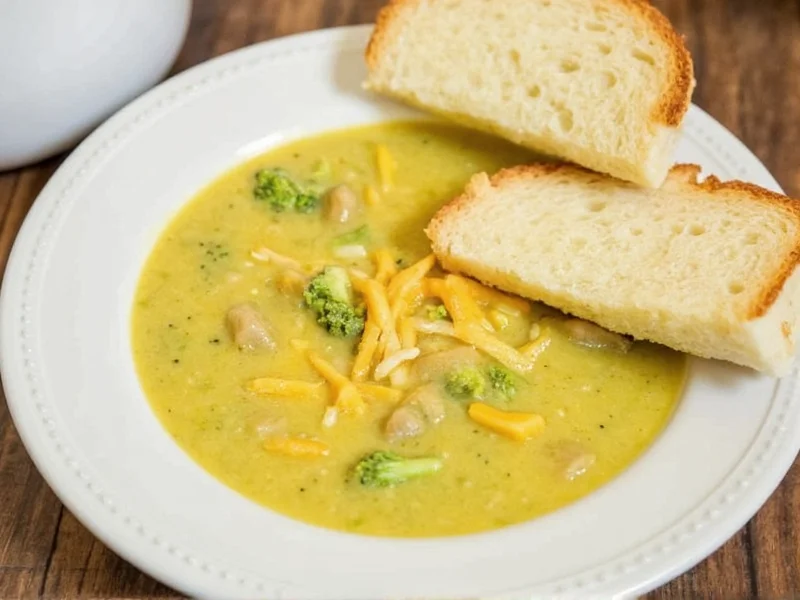Creating the perfect easy broccoli cheddar soup doesn't require culinary expertise or specialty equipment. The secret lies in understanding cheese behavior and proper ingredient sequencing. When made correctly, this comforting classic features vibrant green broccoli florets suspended in a velvety cheese sauce that coats the spoon without becoming grainy or separating.
Essential Ingredients for Success
Quality ingredients form the foundation of exceptional broccoli cheddar soup. Unlike versions relying on canned soup shortcuts, this approach uses whole food components that deliver superior flavor and texture. The cheese selection particularly impacts results—sharp cheddar provides the ideal balance of flavor and meltability.
| Ingredient | Measurement | Preparation Notes |
|---|---|---|
| Fresh broccoli | 4 cups florets | Cut uniform 1-inch pieces |
| Sharp cheddar | 2 cups shredded | Block cheese, freshly grated |
| Yellow onion | 1 medium | Finely diced |
| Garlic | 2 cloves | Minced |
| Butter | 3 tablespoons | Unsalted |
| All-purpose flour | 3 tablespoons | For roux |
| Chicken or vegetable broth | 4 cups | Low-sodium |
| Whole milk | 1 cup | Alternative to heavy cream |
Step-by-Step Preparation Guide
Follow this streamlined method for foolproof broccoli cheddar soup every time. The key is maintaining proper temperature control when adding cheese to prevent clumping or separation.
- Sauté aromatics: Melt butter over medium heat, then cook onions until translucent (5 minutes). Add garlic and cook 1 minute until fragrant.
- Create roux: Whisk in flour and cook 2 minutes until golden, stirring constantly to eliminate raw flour taste.
- Build base: Gradually whisk in broth, ensuring no lumps form. Bring to gentle simmer.
- Add broccoli: Stir in florets and simmer 12-15 minutes until tender but still vibrant green.
- Incorporate dairy: Reduce heat to low, then slowly whisk in milk. Remove from heat completely before adding cheese.
- Melt cheese: Gradually stir in shredded cheddar until fully melted and smooth. Never boil after adding cheese.
- Season: Add salt, pepper, and optional pinch of cayenne. Adjust seasoning to taste.
Proven Techniques for Perfect Texture
Avoiding grainy or separated soup requires understanding cheese chemistry. Cheddar contains casein proteins that tighten when exposed to high heat, causing separation. The solution involves three critical steps:
- Always remove soup from heat before adding cheese
- Use freshly grated cheese (pre-shredded contains anti-caking agents)
- Add cheese gradually while stirring constantly
For extra creaminess without heavy cream, blend 1 cup of cooked soup with ½ cup milk, then stir back into the pot. This technique creates natural thickness while maintaining a light texture.
Variations and Customizations
This adaptable easy broccoli cheddar soup recipe welcomes creative modifications. Consider these tested options:
- Lighter version: Substitute half the cheese with nutritional yeast and use low-fat milk
- Smoky twist: Add 2 strips cooked bacon and ¼ teaspoon smoked paprika
- Gluten-free: Replace flour with cornstarch (2 tablespoons mixed with cold broth)
- Extra protein: Stir in 1 cup shredded cooked chicken at the end
Serving and Storage Recommendations
Serve immediately with crusty bread or oyster crackers for optimal texture contrast. Leftovers maintain quality surprisingly well when stored properly:
- Cool completely before refrigerating in airtight containers
- Consume within 4 days for best quality
- Reheat gently over low heat, adding splashes of milk if needed
- Freeze without dairy for up to 3 months (add milk/cheese when reheating)
Troubleshooting Common Issues
Even experienced cooks encounter challenges with cheese-based soups. Here's how to fix frequent problems:
- Grainy texture: Remove from heat, add tablespoon of lemon juice or vinegar, and blend until smooth
- Too thick: Gradually whisk in additional warm broth until desired consistency
- Too thin: Simmer uncovered briefly or create a slurry with cornstarch
- Bland flavor: Enhance with 1 teaspoon Dijon mustard or 2 tablespoons white wine
Frequently Asked Questions
Can I use frozen broccoli for easy broccoli cheddar soup?
Yes, frozen broccoli works well in this recipe. Thaw and drain thoroughly before adding to prevent excess water from diluting the soup. Add frozen broccoli directly to the simmering broth and cook 2-3 minutes longer than fresh.
Why does my broccoli cheddar soup become grainy when cooling?
Graininess occurs when cheese proteins tighten during cooling. Prevent this by removing the soup from heat before adding cheese, using freshly grated cheese, and incorporating a small amount of sodium citrate (1/8 teaspoon per cup of cheese) which stabilizes the emulsion.
How can I make broccoli cheddar soup without flour?
Create a flourless version by blending 1 cup cooked cauliflower with 1 cup broth until smooth, then adding to the soup base. This provides natural thickening while maintaining a gluten-free profile and enhancing vegetable flavor.
What's the best cheese combination for creamy broccoli cheddar soup?
For optimal creaminess and flavor, combine 1½ cups sharp cheddar with ½ cup Gruyère cheese. The Gruyère melts smoothly while adding nutty complexity that complements the broccoli without overwhelming the cheddar flavor.











 浙公网安备
33010002000092号
浙公网安备
33010002000092号 浙B2-20120091-4
浙B2-20120091-4